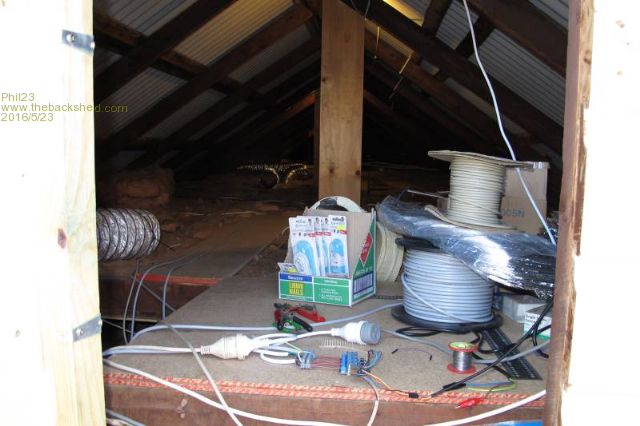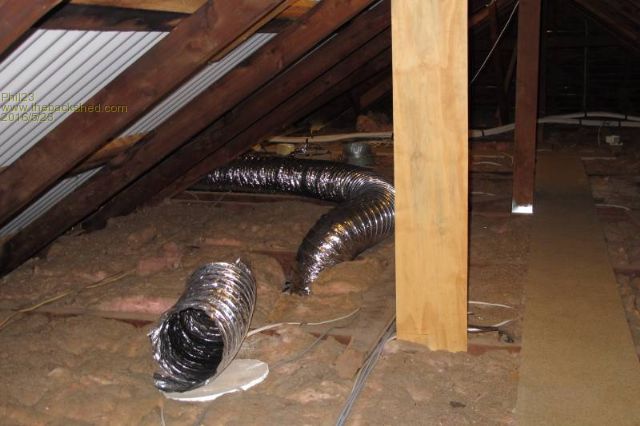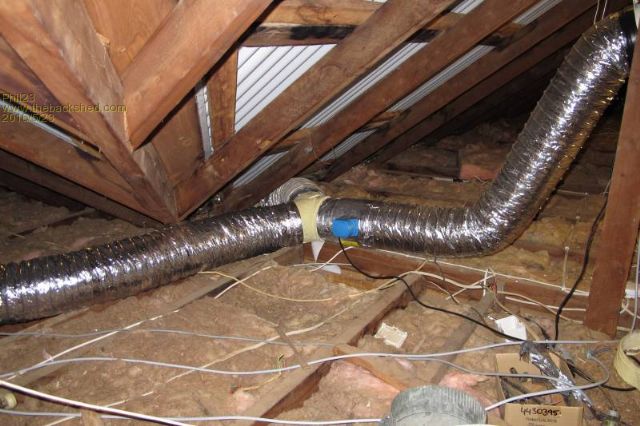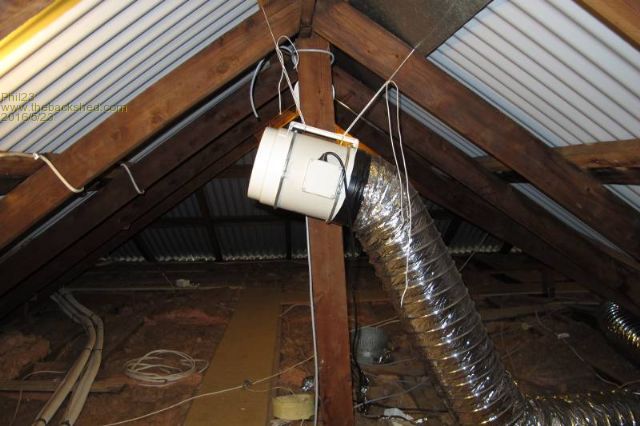
|

|
Forum Index : Microcontroller and PC projects : Micromite Actually Working...
| Author | Message | ||||
| Phil23 Guru Joined: 27/03/2016 Location: AustraliaPosts: 1664 |
As of yesterday afternoon one of my Micromites is actually working; As in doing a job. Wasn't sure whether to post here or in the Solar Forum. It is still a giant Birds Nest on a breadboard at this stage; Sitting on my armrest. Not using an LCD Touch screen yet, as I wanted to play with one of the older modules. 

But it does have cabling up to the hardware in the roof. 
As mentioned in another post, the relay module can drive the fan on either low or high speeds, & also opens & closes damper valve. 
At this stage ducting is to the Main Lounge & Kitchen/Dining rooms which are fairly open planned. 

The motorised damper closes the ducting off when the fan is not running to prevent heat loss. 
The fan draws 105 Watts on high & displaces 840 cubic metres of air per hour. The main living area, plus adjoining Office/Spare bedroom have a total volume for 215m³, so air turnover is about 4 times per hour. 
An inlet filter for the fan is work in progress, but there is little transfer of dust as it is not disturbed by the fan action. More vents & dampers are to be added, along with a return air vent including damper. Only using 2 Temp sensors at this stage, just wired to individual pins, as the each room sensors are not in place yet. 5:00am this morning it was 18°C inside & the fan kicked in around 8:30, when the ceiling temp reached 20°C, (Differential coded at 2°C) Only running basic code at this stage, as I decided to re-write from the ground up last night. The other code I have will be brought in later. The photo taken at about 4:15pm shows the Inside temp as 25.5°C, on a not so warm day that barely saw 20°C. Not bad heat recovery. 24°C was reached in about 2 hours. 
The Green LED seen in the pic inverts with every cycle of the main loop to indicate the code is running, and is held on while the Temp sensors are being read. The Red one indicates the fan is running. Like I mentioned, the code loaded is only basic, but I want to add the other components back in in a tidy & orderly manner. At least it's running & cutting back on heating expenses. [Code] '''''''''''''''''''''''''''''''''''''''''''''''''''''''''''' 'Ceiling Space Heat Recovery Controller (Basic). 'Phil Porritt, 22/05/2016. '''''''''''''''''''''''''''''''''''''''''''''''''''''''''''' Option autorun on Option Explicit Option Default None Dim float TempLng1, TempBed1=22.0, TempAmb1=18.5, TempRoof, TmpDif=3.0, Farenheit Dim string Esc=Chr$(27), FanStat 'Pins used - Inputs Dim Integer TsLng1=15 Dim Integer TsRoof=16 'Pins used - Outputs LCD INIT 23, 24, 25, 26, 17, 18 Dim Integer RlFanHi=2 Dim Integer RlFanLo=3 Dim Integer RlDamp1=4 Dim Integer RlSpare=5 Dim Integer StatLed=9 'Status Pin LED (Green) Blinks to show main loop is running 'Dim Integer RunLed= 'Fan Running (Red LED) & also damper open setpin(StatLed),dout 'Setpin(RunLed),Dout Setpin RlFanHi,Dout,OC : Pin(RlFanHi)=1 Setpin RlFanLo,Dout,OC : Pin(RlFanLo)=1 Setpin RlDamp1,Dout,OC : Pin(RlDamp1)=1 Setpin RlSpare,Dout,OC : Pin(RlSpare)=1 Print Esc+"[2J" Do Watchdog 20000 'Reset after 20 second if the program stops Pin(StatLed)=Not Pin(StatLed) 'Invert Status LED with each loop to show main loop is still running ' Get the Temperatures at timer interval DS18B20's on separate inputs if timer>5000 then Pin(StatLed)=1 'Hold Status LED on whilst reading temps TempLng1=Tempr(TsLng1) TempRoof=Tempr(TsRoof) Farenheit=DegCF(TempLng1) Timer=09 Endif If TempLng1<(TempRoof - TmpDif) Then FanStat="Running" 'Turn the Fan on & open the damper pin(RlFanHi)=0 : Pin(RlDamp1)=0 else if TempLng1>(TempRoof+TmpDif) then FanStat="Off" 'Turn the Fan off. pin(RlFanHi)=1 : Pin(RlDamp1)=1 endif LCD 1, 1, "Lounge Temp" : lcd 1,17, Str$(TempLng1,2,1) LCD 2, 1, "Bedroom Temp" : LCD 2,17, Str$(TempBed1,2,1) LCD 3, 1, "Ambient Temp" : LCD 3,17, Str$(TempAmb1,2,1) LCD 4, 1, "Roof Temp" : LCD 4,17, Str$(TempRoof,2,1) Print Esc+"[f"; Print "Lounge Temp = ", Str$(TempLng1,2,1) Print "Bedroom Temp = ", Str$(TempBed1,2,1) Print "Ambient Temp = ", Str$(TempAmb1,2,1) Print "Roof Temp = ", Str$(TempRoof,2,1) Print "F/heit Temp = ", Str$(Farenheit,2,1) Loop Function DegCF(Celcius As Float) as Float DegCF=Celcius*9/5+32 End Function [/code] It's good to have one doing something functional for the first time. Cheers Phil. |
||||
| WhiteWizzard Guru Joined: 05/04/2013 Location: United KingdomPosts: 2794 |
Great work there Phil 
It is always good to hear how MicroMites are being put to use. I reckon there are lots more out there that people should post - no matter what it is the MM is being used for. And I know Geoff likes to hear about how his 'invention' is being used in the 'real world' - so keep on posting . . . Please do keep us all informed of progress with your exciting venture 
For everything Micromite visit micromite.org Direct Email: whitewizzard@micromite.o |
||||
| Phil23 Guru Joined: 27/03/2016 Location: AustraliaPosts: 1664 |
Always had an interest in Thermal Physics & Energy measurement & usage. (Anything that involves DATA....). Obviously need to bring all the other code in & plan to record a few maximums & minimums. Possibly use some diverters to move air between rooms once the sun is down & the wood fire is going. I don't expect it to replace my other forms of heating, but to supplement it, & lower the use of Reverse Cycle & wood heating by preserving thermal mass within the house & hence requiring less inertia to get that extra warmth of an evening. Come Summer, the plan is to make additions to allow the system to vent hot air from the roof space in order to lower the ceiling temperatures. Once all the other code I've got is brought into the unit now running, it will have a LCD Backpack & Internet access. Plan B after that is to start afresh with a MicroMite Plus, with plans for the final version to have either a 5 or 7" touch screen. Looking forward to playing with that. Cheers. |
||||
MicroBlocks Guru Joined: 12/05/2012 Location: ThailandPosts: 2209 |
I would keep an eye out for some better relais. I have had the exact same ones failing on me several times, not sure if it was the optocoupler or the relais itself. If they are in important (critical) places maybe opting for a solid state relais might be better. It should be an easy replacement once needed. Microblocks. Build with logic. |
||||
| Phil23 Guru Joined: 27/03/2016 Location: AustraliaPosts: 1664 |
Yes I don't place a real lot of faith in them. Contacts are rated at 10 amps, not sure what the PCB tracks would handle though. Current thru them is low at least. Is there such thing as a double throw Solid State Relay? I use the NC contacts on the damper relay to feed it's drive close motor. Other thing? Am I wrong in using pins 2,3,4 & 5 in as DOUT, OC to actuate the relays when the VCC to the relays is 5 volts? Thanks Phil |
||||
Grogster Admin Group Joined: 31/12/2012 Location: New ZealandPosts: 9082 |
Is that "Insulfluff" on top of the bats in the roof? I'm surprised that there is no roofing paper under the corrougated iron to prevent condensation from dripping off onto the inside of your roof. However, you Aussies have hotter weather then we Kiwi's, so perhaps that is the reason - maybe it never gets cold enough, but still, in the winter I would have thought..... Nice project there, and thanks for all the photos. I always like looking at photos of people's projects. Keep up the good work. 
As your relay board is opto-coupled, you could just use direct outputs to drive the LED in the opto without issues. However, having them set as OC won't hurt the situation I wouldn't think. Smoke makes things work. When the smoke gets out, it stops! |
||||
| Phil23 Guru Joined: 27/03/2016 Location: AustraliaPosts: 1664 |
No, It's probably "InsulDust" & InsulSawDust". Been in this place since '92 & the original roof was replaced after a hail storm in 1995, talking Cricket Ball size & larger. All new iron & labour covered by insurance, but the budget at the time would not extend to, foil under the iron, (Insulation backed would have been good). Most of the spare time & cash I had at the time was devoted to replacing the cotton covered wiring in the skillion sections of the roof, that could only be accessed whist the iron was off; the other could be done later. I went thru just short of 200m of cable replacing the cotton covered rubber stuff in steel conduit with new cabling; No more sparks & crackles though. Having insulation under the iron would be preferable in this case as the cavity temp would take longer to drop after dark, providing a bit more energy into the evening. As can be seen in some of the photos, by the light leaking under the eves, the roof cavity is not really sealed. Don't seem to have a condensation problem in out climate as the heat seems to drive the humidity out of the roof cavity. Cheers. |
||||